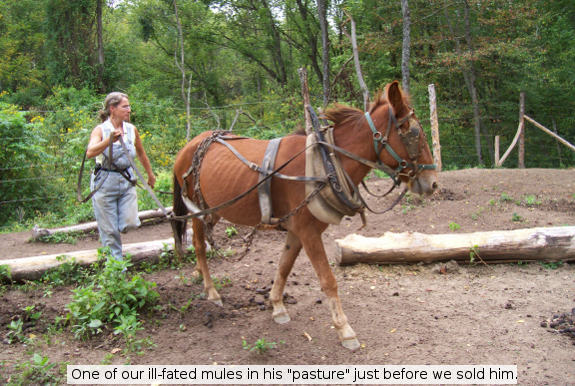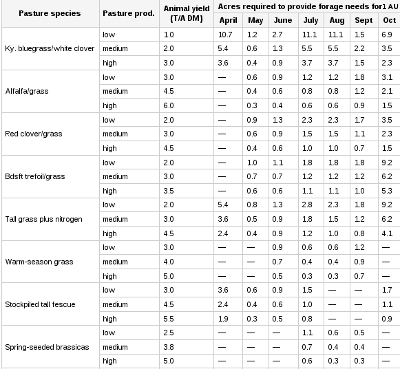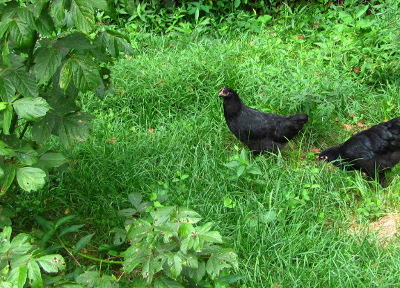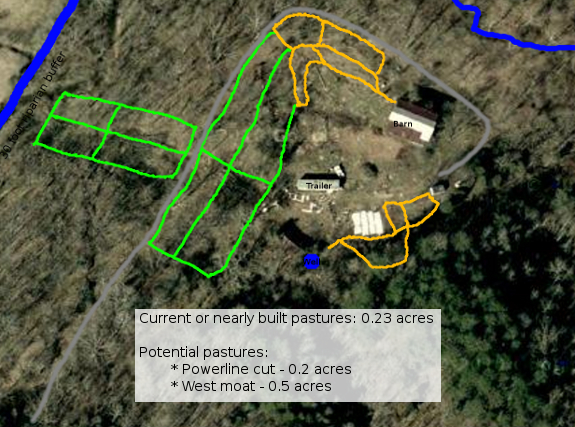
How many miniature sheep per acre?

Years ago, we learned
the most important lesson of animal husbandry --- have sufficient
pasture before bringing your new livestock
home. But how many acres do you need for a sheep or goat or cow?
The trouble with
answering this question is that an arid pasture in the western U.S.
might support only a fifth as many animals per acre as a lush pasture
in the southern Appalachians. So animal scientists have come up
with what are known as "animal units" which compare all kinds of
different livestock to a 1,000 pound beef cow. An average
full-size sheep is 0.2 AU, which means you can keep five sheep in the
same space as the average beef cow. Here are some figures for
other livestock you might be interested in:
 Mature bull - 1.5 AU
Mature bull - 1.5 AU- 450 pound calf - 0.5 AU
- Holstein cow - 1.5 AU
- Work horse - 2 AU
- Saddle horse - 1.25 AU
- Boar - 0.5 AU
- Brood sow - 0.25 AU
- 100 pound feeder pig - 0.05 AU
- Mature sheep - 0.2 AU
- Mature goat - 0.17 AU
- Roaster chicken (or, presumably, a layer) - 0.004 AU
- Heritage breed broiler chicken - 0.0025 AU
- Cornish cross chicken - 0.0015 AU
Within a species, you
can estimate that the amount of pasture an animal needs is roughly
proportional to how much it weighs. So, if you're pasturing
bantams, they'll need a good deal less pasture than for standard-sized
chickens, and ditto if you're raising miniature
sheep or dwarf
goats. The
figures I found on the internet suggest that an average Miniature
Cheviot sheep weighs about 43% as much as a full-size sheep, so each
one would be equivalent to 21.5 chickens instead of 50 chickens.
 We've never raised cows on
our land, but I have figured out that our
chickens need at least 270 square feet apiece to keep from degrading
the pasture.
That means we should plan on at least 0.325 acres for a herd of 2.5
miniature sheep (mama, papa, and baby.) If we wanted to keep a
similar herd of full-size sheep, we'd need 0.75 acres fenced in.
And if we didn't want to give the sheep any supplemental feed in the
winter, we'd probably need to double those numbers.
We've never raised cows on
our land, but I have figured out that our
chickens need at least 270 square feet apiece to keep from degrading
the pasture.
That means we should plan on at least 0.325 acres for a herd of 2.5
miniature sheep (mama, papa, and baby.) If we wanted to keep a
similar herd of full-size sheep, we'd need 0.75 acres fenced in.
And if we didn't want to give the sheep any supplemental feed in the
winter, we'd probably need to double those numbers.

Mark's been building
pastures like mad all year, and if we finished up the two he recently
started, we'd already have almost a quarter of an acre fenced in.
Maybe miniature sheep wouldn't have to be pushed as far into the future
as I thought?
Want more in-depth information? Browse through our books.
Or explore more posts by date or by subject.
About us: Anna Hess and Mark Hamilton spent over a decade living self-sufficiently in the mountains of Virginia before moving north to start over from scratch in the foothills of Ohio. They've experimented with permaculture, no-till gardening, trailersteading, home-based microbusinesses and much more, writing about their adventures in both blogs and books.
Want to be notified when new comments are posted on this page? Click on the RSS button after you add a comment to subscribe to the comment feed, or simply check the box beside "email replies to me" while writing your comment.

Aren't beef cows usually kept in small pens and fed on lots of corn and antibiotics? How is that factored in to the calculations?
Interesting to see that a horse needs more space than a cow. Is that because horses need room to move, or do they eat more?
From the photo, it seems like the mules didn't have any trouble clearing the overgrowth.
Roland --- That is the industrial model, but the AU calculations assume you're raising your animals on pasture instead. You'll still be feeding them some amount of supplemental grain and/or hay, primarily in the winter, but my understanding is that the model used to factor AUs assumes the animals are getting nearly all of their forage from pasture in the spring, summer, and fall. (With omnivores like pigs and chickens, they won't be getting nearly all of their nutrition from pasture even during those periods, but they'll be getting the maximum amount they can.)
I suspect the horse vs. cow distinction is a male/female thing. You'll notice a bull actually needs more pasture than the average saddle horse --- I think there's more sexual dimorphism among cattle than horses. The work horse presumably needs more pasture both because it's working and because they tend to be heftier animals.
Our mules definitely cleared the overgrowth...and the undergrowth...